Hello, readers and visitors to the blog "build a house." Remember, in the last article about, we were going to discuss with you how to do it thermal insulation of walls with own hands. This is what we are going to do with you. Go.
How and what to insulate the walls of the house?
Correct thermal insulation for walls with their own hands allows you to significantly reduce the material consumption and labor costs of construction, because with the use of modern insulation for walls, there is no need to build walls of maximum thickness. It is enough to do with an easy design.
The facade of the house can be insulated inside, outside and inside the walls. Many prefer external insulation systems. First, it is an additional protection of the walls of the house from external influences (biological, atmospheric and temperature), secondly, the ease of installation of thermal insulation for the walls, besides, it eliminates the accumulation of condensate on hidden surfaces. In addition, additional sound insulation is formed and the "breathing" of the walls is not interrupted.
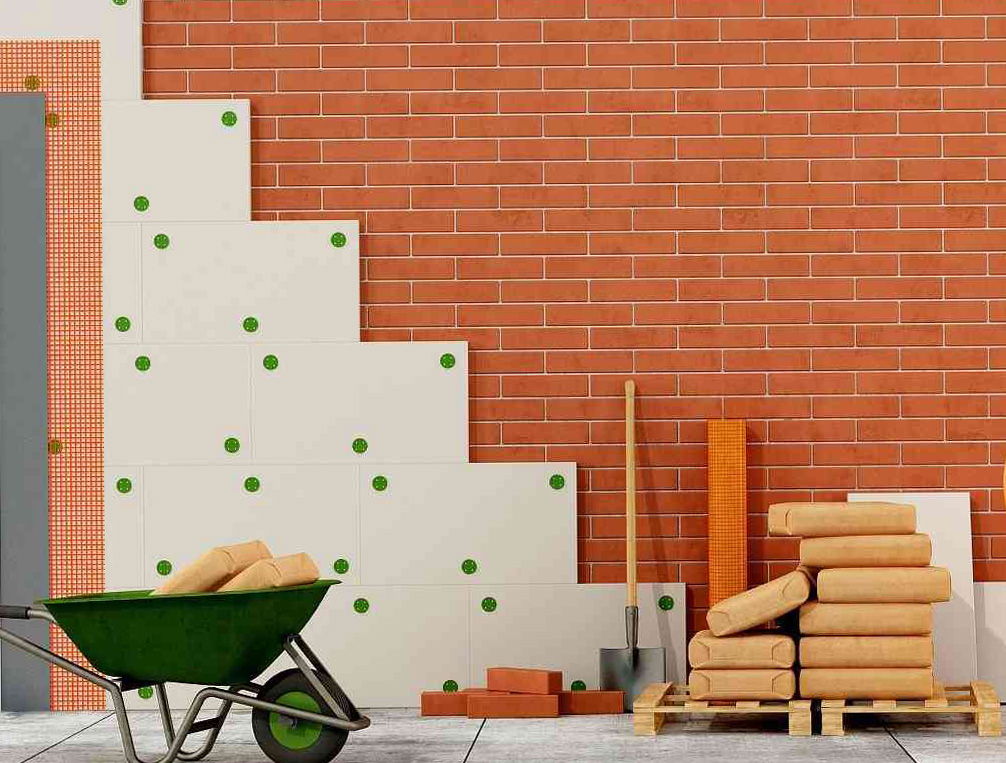
Home insulation system
Lightweight plastering insulation system looks like a layer of insulation, fixed on the wall with plastic dowels and glue, and a thin stucco layer on top. The total thickness of the layers is not more than 15 mm. This version of the thermal insulation system offers the involvement of qualified specialists and requires the use of high-quality thermal insulation materials.
Plate heater with a massive plaster thermal insulation system fixed by means of anchors and reinforced mesh. The thickness of this layer can reach up to 50 mm. Attraction of highly qualified specialists, for leveling the facade surface, is not required.
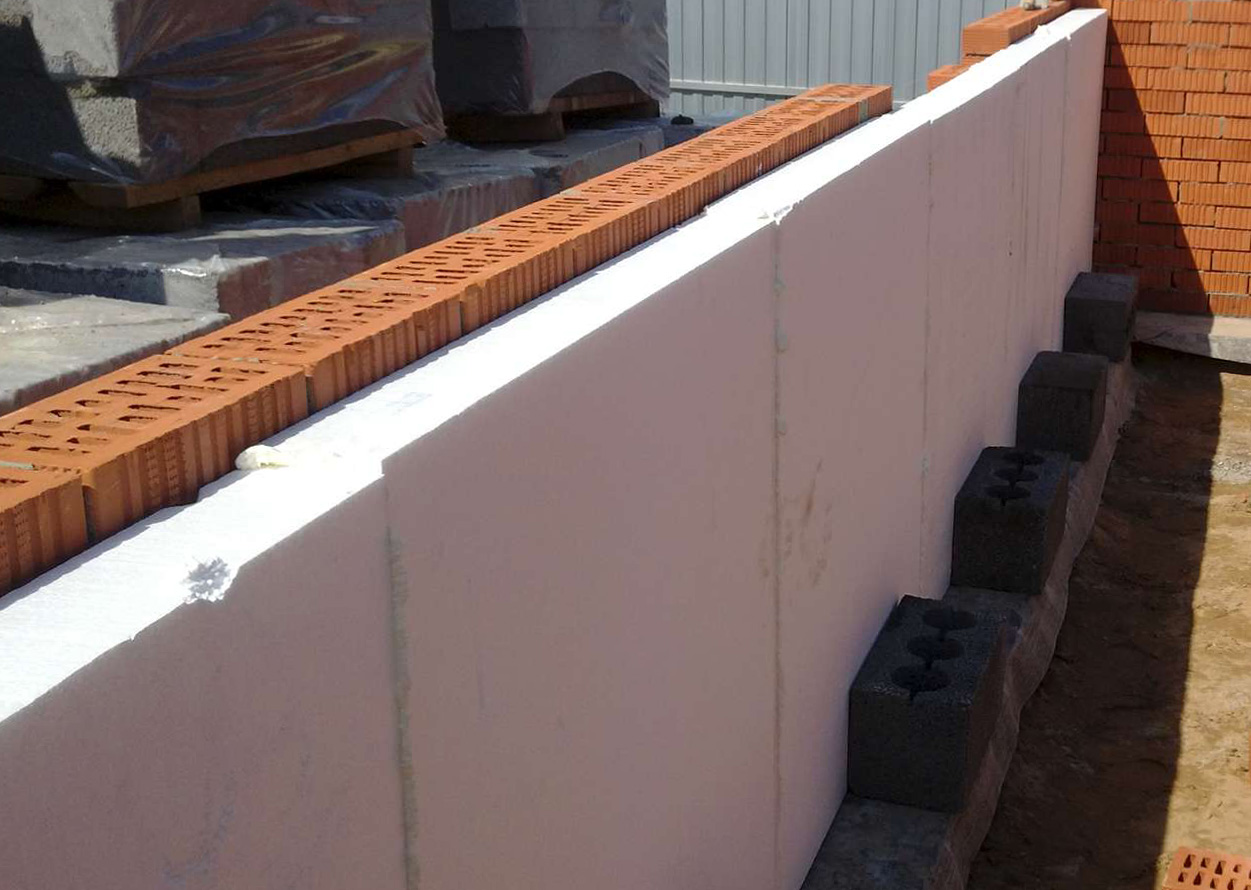
AT facade three-layer thermal insulation systems with a casing, the heater is placed inside the obstructing structures. The first layer is an internal load-bearing wall. Its thickness is determined by the requirements of the strength of the wall. The second layer is insulation thickness, depending on the thermal insulation requirements. And the outer (front) layer closes the thermal insulation for the walls from external influences.

The ventilated facade thermal insulation system is somewhat similar to that of a sump. But instead of the outer face layer, different facing materials or plates are used. The thermal insulation for the walls with their own hands, in this case, is fixed to the walls using an anchoring system and a supporting frame.
Device "Thermoshubes" - what is it?
Due to the reliability, functionality and ease of the device in recent years, more and more is gaining popularity thermo-tubing device. This multi-layer thermal insulation of the walls is more suitable for a complex system of insulation and external already built, heated houses.
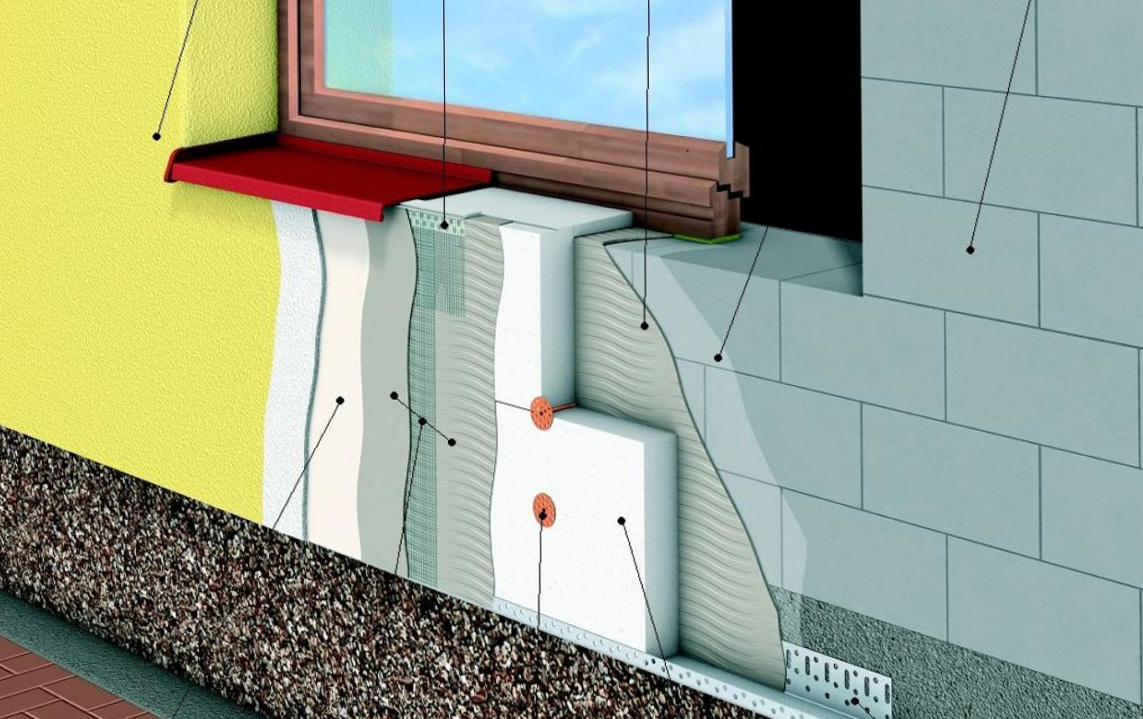
What is the advantage of a thermoshub?
The device "thermoshub" has a number of advantages:
• guarantees optimal temperature-humidity microclimate in homes;
• increases the life of houses;
• good sound and heat insulation of walls;
• insulation of houses of different storeys without the need to resettle tenants, reinforce foundations, walls;
• the admissibility of year-round work at temperatures from +25 to -15 0 С.
What does the thermoshub consist of?
Thermal insulation "thermoshub" consists of:
• decorative-protective layer with the use of plaster mortar (with subsequent painting or without painting);
• Adhesive compounds reinforced with two or one layer of reinforced mesh;
• thermal insulation layer made of expanded polystyrene or mineral wool. The thermal insulation for the walls is fixed to the surface by dowels-anchors and adhesive mixtures.
When selection of insulation material for thermal insulation of the walls of a private low-rise house, pay attention to polystyrene. It is lighter and cheaper than mineral wool, it is characterized by water resistance, low thermal conductivity, resistance to deformation and stability of the structure.
Unlike some other thermal insulation for walls, it has deformation resistance, sound absorption, hydrophobicity and fire resistance. More often it is used in buildings located in places with increased level of external noise, public buildings and multi-storey buildings. In private housing construction, it is also in great demand.

For plaster and adhesive in a multi-layer "cake" dry construction mixtures are used. Plaster solutions provide architectural and aesthetic coloring to the insulating structure, and glue - a highly effective thermal insulation. Adhesive composition is applied to the board in a continuous or pointwise-side way using a notched trowel. The adhesive bonding area should not be less than 40% of the plate area. To form a protective-reinforcing layer, a glue composition is applied over the insulation. Apply it with a notched trowel, and to smooth the surface and fix the mesh use a smooth spatula.
Consumption of materials: 1 m 2 of overlap in the thickness of the layer 1 mm account for 1.8 kg of dry mixture. The production and application of adhesive compositions is performed at a temperature of + 30 to +5 0 C. But there are also high-strength adhesive compositions that are suitable for negative temperatures.
Durability and mechanical strength of the "thermoshub" device guarantees additional fixing of the plates of the thermal insulation system with the help of plastic dowels. The holes under the dowels are drilled already in the glued panels. In the hole insert a dowel, into which a special nail is driven. On the plate leaves 5 dowels: one in the center and four in the corners. The lower row of plates of the thermal insulation system must be strengthened additionally with the help of a galvanized profile.
The final part of the thermal insulation for the walls with your own hands

For final exterior finishing devices of "thermoshub" Used plaster mixes with contained decorative textures ("bark beetle", "croup", etc.). Using a steel float, the mixture is evenly applied to a base with a thickness of approximately 2.5 mm. After 15-20 minutes, the solution can be processed with a plastic float before the necessary texture is formed. Dilute the mixture with water during the execution of the work is not recommended. Prepare and apply the mixture at a temperature of +25 to +5 0 C.
During the work and after their completion within 24 hours, the exposed surfaces must be protected from the active effects of rain, wind, sun rays and other negative factors. This can be done by arranging a small canopy of polyethylene.
To protect the socle layer and corners from mechanical influences, perforated aluminum or galvanized corners are used.
Well, here we are and we finished the article with thermal insulation for the walls with our own hands. Now we can definitely determine, how and what to insulate the house.
I brought only the most popular thermal insulation systems. In fact, there are many of them. On this I say goodbye to you before new articles. By the way, in order not to miss the release of new articles, I advise you to update the blog. And the next article I'm thinking about writing about. For now, until new articles.
To warming the house and especially important objects you need to approach very carefully. Unfortunately, people pay little attention to the insulation of the roof.
During the heating process, the air starts to rise. The flat roof is special in that it separates the warm inner and cold outside air.
As a result of the sudden cooling of air, a condensate forms on the structure, which often causes destruction.
The flat roof insulation allows not only to reduce heat loss, but also to protect it from condensation.
Features of insulation
Often, flat roofs are made in the form of a soft roof. In this case, a carrier plate is arranged, on top of which is laid a vapor barrier and a heat-insulating material. 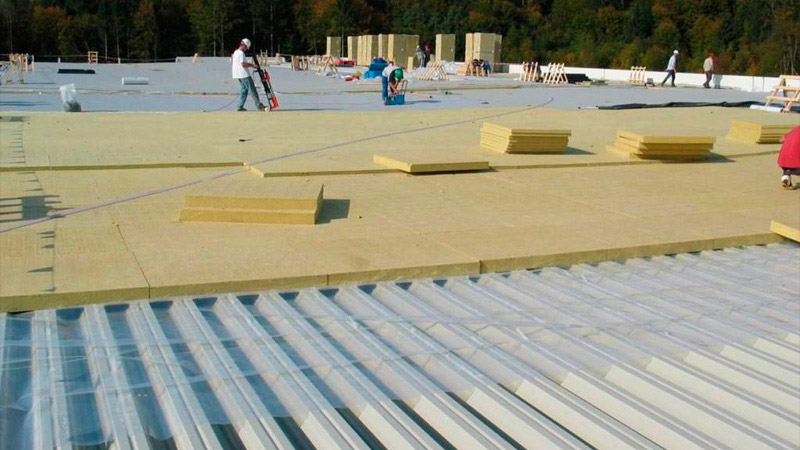
This coating can protect the coating from the negative effects of rain and melt water. Classical flat roof is a layered pie, which consists of the following elements:
- Support plate;
- Fasteners for a heater;
- Insulation;
- Waterproofing;
Often, such roofs are used in residential and industrial buildings. So, a large number of residential multi-storey buildings have this type of roof. 
Inverted roofs
To improve the technical characteristics of flat roofs, modern building technologies are used.
With the help of inversion structures, it is possible to create such an overlap that will have high thermal insulation properties. Such a design consists of the following elements:
- A layer of gravel. The thickness of this layer should not be less than 5 cm;
- Filtering layer;
- Waterproofing material;
- Screed and overlap.
The peculiarity of this design is that the insulation material in it is located above the waterproofing membrane, and not under it. 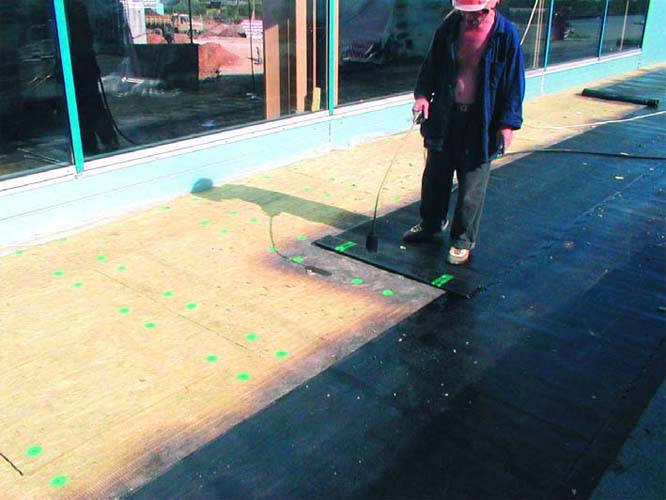
Thanks to this design, it is possible to protect the waterproofing layer from negative environmental factors.
As a result, it is possible to extend the service life of not only a monolithic plate, but also a heat-insulating layer.
Basic requirements for thermal insulation
Flat roofing must meet certain requirements. The main element of a flat roof is a slab, which consists of a reinforced concrete slab or a profiled sheet.
When constructing such a roof, a roof slope is created, which facilitates the draining of rain and melt water.
To create a slope, use a reinforced concrete screed or an embankment of expanded clay. To the device of such a design and its thermal insulation, special requirements are imposed.
Additional Information:
During operation, the thermal insulation layer will withstand the negative impact of the external environment.
Therefore, special requirements are imposed on its design. Since rain and melt water will act on it, it must be hydrophobic. In order to protect it from loads and negative factors, a screed device is being installed.
Design features of thermal insulation
The thermal insulation of the roof can be carried out in several layers. Single-layer insulation is carried out with a single-density heater. 
At the same time, the device of the same screed is being carried out. All these works should be envisaged at the planning stage of the building.
In some cases, can be carried out during the reconstruction of the structure. Often, single-layer insulation is carried out during the construction of warehouse buildings.
Two-layer thermal insulation is carried out in several stages. As it is clear from the title, such insulation consists of two heat-insulating layers.
The first layer performs the main function - thermal insulation. Its thickness can reach 17 cm. As for the top layer, it performs a more protective function. 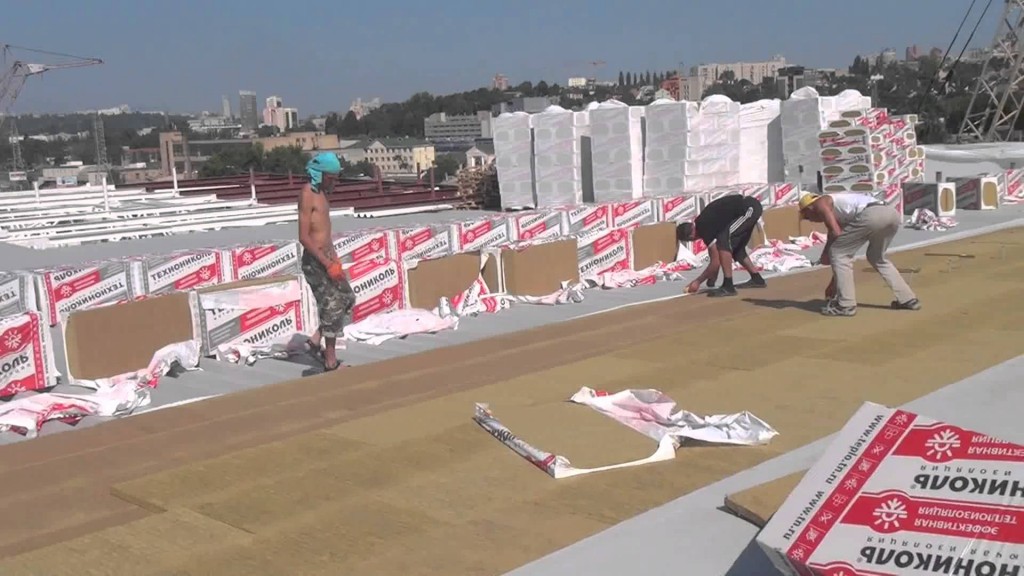
For this, high-density materials are used. The thickness of the layer is close to 4 cm.
The role of the vapor barrier layer
A vapor barrier membrane is laid on the main heat-insulating layer. It should be of high quality, which will reliably protect the insulation from evaporation.
If the thermal insulation material gets wet as a result of the operation, it will lose its heat-insulating properties.
For the vapor barrier device, film materials are often used. This can be a polypropylene or polyethylene film. 
Of course, the use of such materials has some drawbacks. First of all, it concerns the presence of joints.
To eliminate such a disadvantage, it is possible to use the waterproofing as a bitumen.
Thermal insulation materials
For the thermal insulation of a flat roof, various materials can be used. Most often for this use loose heaters.
It can be expanded clay or pearlite sand. The main advantage of this thermal insulation is its low cost. 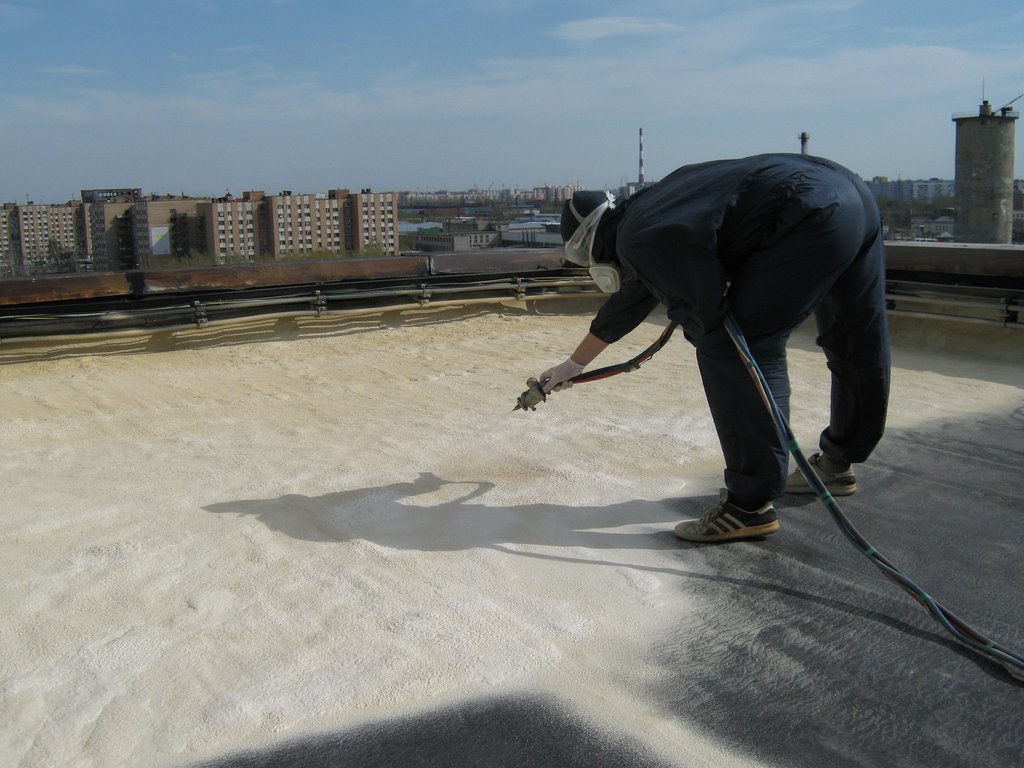
As for thermal insulation properties, such materials are somewhat inferior to modern analogues. When constructing such insulation, do not forget about the slope, with which you can ensure the flow of water from a flat roof.
To the device of warming a flat roof it is necessary to approach very carefully. For this you can use not only expanded clay, but also modern materials.
Instruction on video:
This can be mineral wool, basalt slabs, extruded polystyrene foam and others. The use of such materials often requires a screed device. Therefore, it is better to entrust such work to professionals.
After building a reliable roof, you need to make sure that it does an excellent job of protecting your home from rain, and think about its thermal insulation, as heat leakage in most cases occurs through the roof. By the way, the process of thermal insulation of the roof in importance is in the second position after the creation of the tightness of the coating. With all the variety of roof structures, the process of its insulation is carried out according to similar principles. And how - now you will know!
The essence of roof insulation
The roof acts as the weakest element in the construction of an apartment building with respect to heat losses. The direction of the heat flows upwards causes much higher heat losses in comparison with the walls and the basement. Heat loss through an unheated roof often reaches 30% of all losses of low-rise buildings. In connection with the growing prices for heating and energy, a significant benefit is the minimization of such losses.
Absence of thermal insulation or incorrect laying of the heater provokes the formation of condensate on the inner surface, which leads to a violation of the microclimate in the house, the formation of fungus and mold. In this case, the roof will be heated by heat streams that come from the attic of the building, so in winter the snow settling quickly on the roof, flowing down the slope and turning into ice and icicles, and also deforming the roof and breaking the waterproofing.

One of the important factors that affect such indicators is the humidity and temperature regime, the maintenance of which provides specific heat insulation materials. For insulation of the roof, materials and methods of thermal insulation are used, which ensure the most qualitative preservation of heat in the house in accordance with the established building codes. The insulation must have a low water permeability and a certain vapor permeability - the ability to skip steam, giving the roof the ability to "breathe".
When constructing private houses, the construction of cold attics was traditionally used, when the main insulation was carried out on the surface of the floors, i. by the floor of the attic. This approach was associated with a lack of thermal insulation material, which could be stacked on rafter structures. The modern approach allows us to warm the under-roof space by the roof structures themselves, creating a full-fledged attic and increasing living space at minimal cost.
Materials for roof insulation
Particular attention should be given to the choice of insulation. To insulate the roof use materials that differ in terms of thermal conductivity, vapor permeability, the level of repulsion of moisture and mechanical characteristics, durability, fire resistance, convenience in work and cost. When buying a thermal insulation material for roof insulation, it is necessary to pay attention to the following criteria:
- Compliance of the material with building codes and ecology standards.
- Scope of material use - choose material exclusively for roofing works.
- Speed and simplicity of installation - a heater should not require a lot of labor and cause difficulties in work.
- The useful life of the selected coating.
- Water-repellent properties - insulation material should not absorb moisture, as its thermal conductivity will decrease several fold.
- Steam insulation characteristics - it is better to choose a thermal insulation material with one side covered with foil.
Select the insulation material so that its thickness provides energy loss of the building, in accordance with the requirements of SNiP, so it should be determined based on the thermal conductivity of a certain material. If there is not enough thickness of the truss structures to organize the appropriate insulation, then to solve this problem it is necessary to use a more efficient insulator with a low level of thermal conductivity.
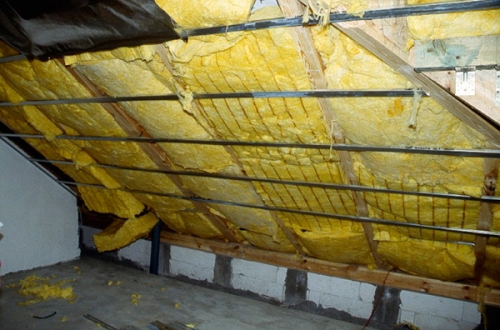
The main characteristic of heaters is the average density. Thermal insulation materials are divided into dense, medium, light and very light in density. Not always high-density materials will provide high thermal insulation values, but are able to withstand more significant mechanical loads and create increased loads on load-bearing structures of a warmed house. Density of insulation is 20 - 200 kilograms per cubic meter. Let's look at the main types of heaters:
- Fiberglass and glass wool. The material has a high level of sound absorption and light weight. The price of thermal insulation of the roof with fiberglass is relatively low. However, in terms of its thermal insulation characteristics, glass wool is not inferior to other heaters.
- Mineral and basalt wool. The insulation is made on the basis of the fibers of the rock, it is made of ready-made rolls or plates of various sizes. Depending on the desired result, it is customary to spread the insulation in one or two layers. The material has low hygroscopicity, provides a high level of sound insulation and does not burn. At manufacture mineralovatnyj a heater passes toxicological and radiological check.
- Extruded polystyrene foam and polystyrene. These materials are easy to handle, light in weight, characterized by minimal thermal conductivity, and are not subject to harmful effects of moisture. Such methods of thermal insulation differ from each other only in thermophysical characteristics: expanded polystyrene (foam foam) is airtight, and foam has a high air permeability. They are both flammable, but this problem can easily be solved with a fire retardant layer and fire retardant impregnation.
- Penofol. This material is a foam polyethylene, which is covered with aluminum foil. Its main features are low thermal conductivity and moisture absorption, as well as a small thickness, which saves space.
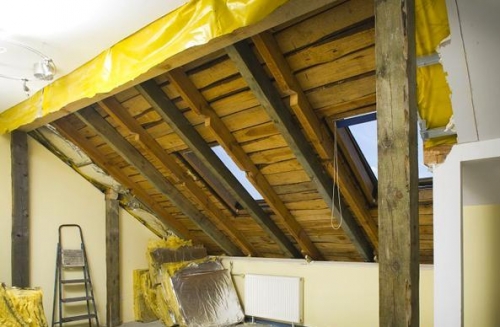
Preparation for installation of thermal insulation
![]()
At the second stage of the preparatory work before fixing the heat-insulating material, it is necessary to check the electrical wiring for serviceability. Repair its damaged parts, replace worn out wires, ring the switches, carefully check all connectors, joints, fasteners and joints. If the electrical wiring is completely unsuitable, it should be remade.
Options for arranging the thermal insulation of the roof
There are many methods of constructing roof insulation in building practice. Which way to use in each particular case will depend on the complexity of the roof structure and the material used to insulate it. Let's look at them in more detail.
Laying of heat-insulating material
There are several methods of laying insulation material:
- The roll method. When creating thermal insulation it is customary to use rolls with a substrate that protrudes on the sides. From roll thermal insulation materials, a foamed insulation with a polymer filler and a substrate is allocated. High level of thermal insulation is achievable due to low density - 15 - 20 kg / cu. meter.
- Printed way. To do this, tighten the metal mesh with mesh, which are 15 by 15 millimeters in size, and fastened with pins that are staggered. Then layer-by-layer backfilling is carried out with the material.
- Zasypnoy way. Such a thermal insulation of the roof is used in the presence of a difference in the intervals between rafters beams. Filler or granulated vermiculite, foam glass or pearlite sand acts as a material for backfilling. The heating process provokes an increase in the volume of vermiculite by approximately 6-8 times. Backfilling is an ideal way to warm non-standard roofs. But this method should not be used in a vented attic to avoid its weathering.
- Sheet insulation. The materials are mineral fiber mats, polystyrene or polyurethane plates. The sheet heat insulator is attached directly to the roof rafters. The cost of its transportation and installation, due to low weight, is much lower when compared with other methods of thermal insulation.
- Blow molding. In the framework of this technique, a mass of fibrous polymer is used as the material, which is fed by blowing through an elastic pipeline. This method is not suitable for attics under roofs of complex shape. For carrying out blowing insulation, it is customary to use a material made on the basis of cellulose fibers clean from the ecological position.
- Sprayed heat insulation. Spraying can be carried out on any surface. Apply foam polyurethane foam on all elements from the inside of the roof, it expands and fills qualitatively all the cracks and cavities. There is no need for additional fastening, because there will not be a single seam. The material is considered resistant to decay and harmful microorganisms, it has a long service life.

Internal and external insulation
Internal insulation is the most popular version of thermal insulation, which is suitable for sloping and flat roofs. Internal insulation of the roof is made by such technology: first lay the inner covering of the room, above it - the vapor barrier, then - the thermal insulation material, then - the wind and waterproofing.
The final thermal insulation layer is the roofing material you have chosen. Remember that the heater must have the necessary width and be adapted to certain climatic conditions. But the main thing at the same time to ensure that the material does not heavier the roof, and provide gaps, which are required to remove from the design of moisture.
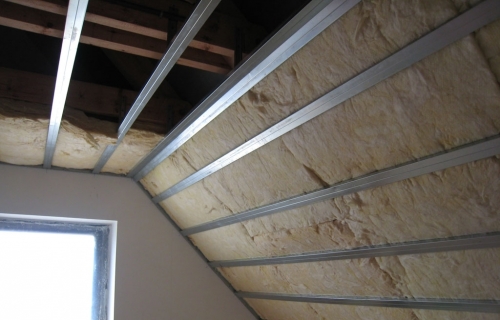
External insulation of the roof is made on the basis of flat roofs with the help of rigid plates, which, therefore, are pressed with concrete slabs or pebbles. When organizing external insulation it is very important to calculate the strength of the roof to protect against the collapse of the roof.
Warming of pitched and flat roofs
The choice of the method of thermal insulation of the pitched roof is carried out, depending on the features of the building. If the house is in operation and you do not provide for the dismantling of the roofing material, the main or additional insulation of the roof should be carried out on the inside of the roof - directly through the rafters.
If the building is only in the process of erection, and you have not assembled the roofing material, then it is worthwhile to insulate the external side of the sloping roofing structures, and the inner lath will serve as a support for the heat-insulating material. To insulate the roof, you can choose one- or two-layer thermal insulation. But it is worth using only a heater, which has the same density.
Pitched roofs on rafters are usually insulated with heat-insulating materials, which differ in low density (25 - 50 kilograms per cubic meter), calculated solely for atmospheric effects and temperature. Remember that materials should not create a heavy load on the structure.
When building a new house for the thermal insulation of a flat roof it is recommended to use a two-layer method of insulation. The lower layer is required for thermal protection, and the upper layer is needed to distribute loads to the entire structure. A single-layer method is used only when repairing and renovating old roofs.
For thermal insulation of flat roofs, it is necessary to use dense insulation, which must withstand significant loads from snow and water, since on such roofs precipitation often accumulates. Flat roofs made from corrugated board are to be insulated with mineral wool, basalt and expanded polystyrene plates, which have a density of about 220 kilograms per cubic meter. The roof on a reinforced concrete slab is warmed with more dense materials, for example, with slabs PPZh-200.
The device of heat insulation of a roof the hands
Roof insulation is a multi-layer system consisting of an internal vapor-proof layer, a heater and an upper membrane material, which is characterized by one-sided moisture permeability. A similar construction is called a "roof pie".
Manufacturers of modern construction materials offer consumers a ready-made "pie", but you can create it yourself and at the proper level of quality. The first layer is a waterproof material that protects the insulation layer from excessive moisture, which comes from the room. Usually, foil, polyethylene and other materials are used.
Laying of the material is carried out on the inner side of the supporting elements without missing a single layer, bonding the joints with sealant and fastening the strips to the wooden structures using galvanized studs or a construction stapler. If it is not possible to lay the material in one layer, it is necessary to create overlaps that should be more than 100 millimeters.
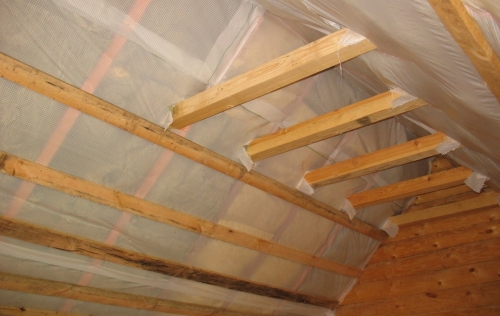
The vapor barrier top layer is necessary to ensure that moisture flows to the outside and prevents it from getting inside to the layer of heat-insulating material. The heat insulation material is laid directly on the vapor barrier material. At the same time, it must be precisely cut to size, since its crushing is not allowed.
You can achieve the planned and calculated efficiency of the thermal insulation of the soft roof only if you prevent the formation of cold bridges when laying the insulation. For this, the roofing material must be laid, not interrupted by other elements of the structure. There should be no planes and depressions in the heat-insulating layer for air passage.
Thus, to save energy resources, to recreate the most comfortable microclimate in the house is capable only of high-quality laying of thermal insulation. Therefore, it is not recommended to save on it, you must strictly follow the technology to avoid such fatal mistakes as the use of material of unsuitable width, installation of insulation of small thickness. Also remember that the maximum possible effect of the roof insulation procedure will be achieved only with a comprehensive approach to the insulation of the house.
